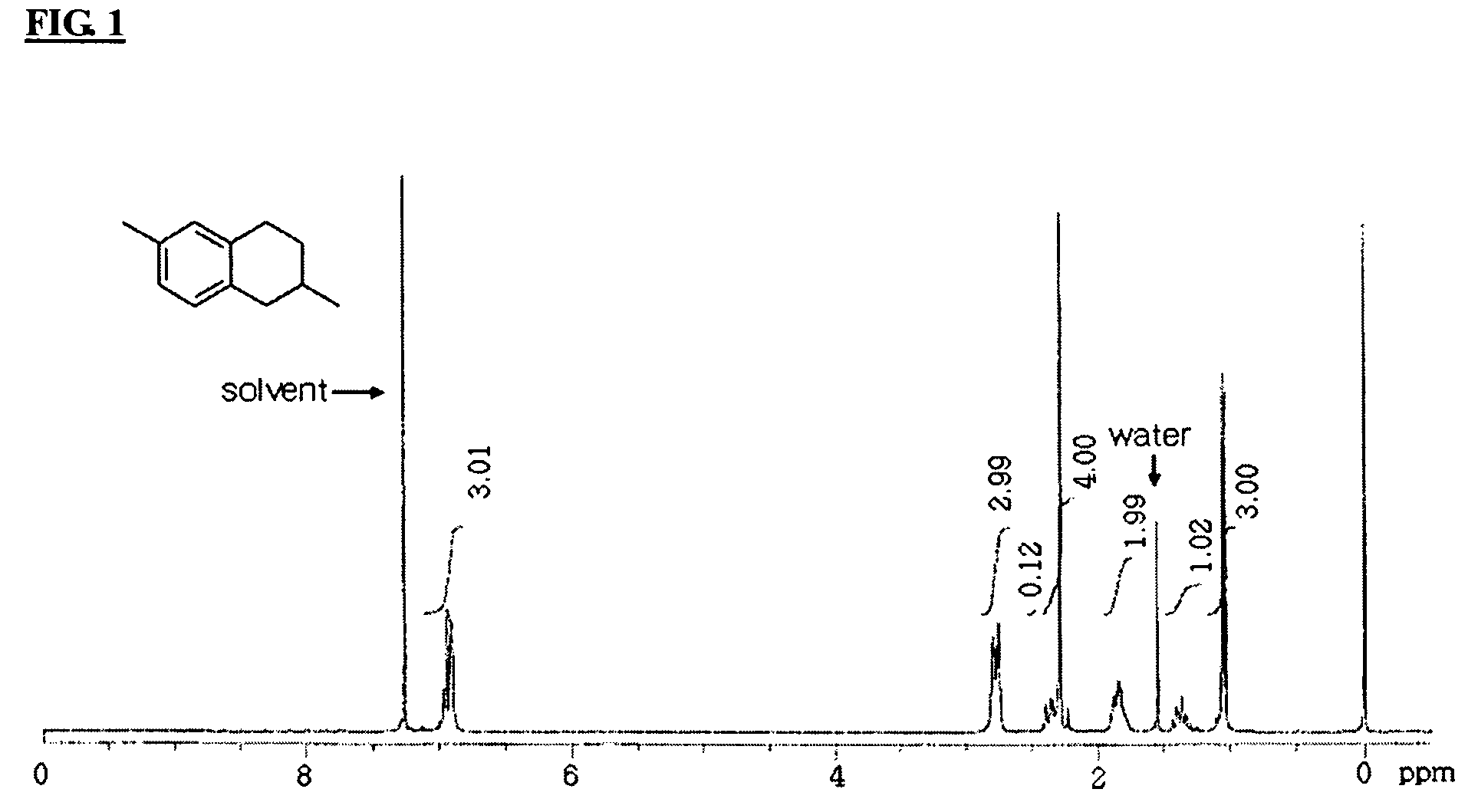Process for preparation of 2,6-dialkyltetralin
a technology of dimethyltetralin and process, which is applied in the field of process for selective preparation of 2,6-dialkyltetralin and the process for selective preparation of 2,6-dimethyltetralin, can solve the problems of complex process, inadequacies, and inability to produce 2,6-dmn in a large scale, and achieve high yield and selective preparation of 2,6-dialkyltetralin
- Summary
- Abstract
- Description
- Claims
- Application Information
AI Technical Summary
Benefits of technology
Problems solved by technology
Method used
Image
Examples
example 1-2
Preparation of alkylated product from the mixture of 1-bromo-4-ethylbenzene and 3-methyl-3-buten-1-ol
[0043]To a solution of 1.46 mmol (270 mg) of 4-bromoethylbenzene in 12 mL of acetonitrile, was added 0.073 mmol (16.4 mg) of palladium diacetate, 0.146 mmol (44.5 mg) of tri-ortho-tolylphosphine, 4.38 mmol (0.61 mL) of triethylamine and 1.46 mmol (0.147 mL) of 3-methyl-3-buten-1-ol. The mixture was refluxed at 80˜81° C. under ambient pressure for 24 hours. As illustrated in reaction formula II, the products were separated to the aldehyde and the mixture of the alkenes with column chromatography eluted with hexane and ethyl acetate (hexane:ethyl acetate=4:1). The yield is demonstrated in Table 1.
example 1-3
Preparation of alkylated product from the mixture of 1-bromo-4-butylbenzene and 3-methyl-3-buten-1-ol
[0044]To a solution of 1.46 mmol (311 mg) of 4-bromobutylbenzene in 12 mL of acetonitrile, was added 0.073 mmol (16.4 mg) of palladium diacetate, 0.146 mmol (44.5 mg) of tri-ortho-tolylphosphine, 4.38 mmol (0.61 mL) of triethylamine and 1.46 mmol (0.147 mL) of 3-methyl-3-buten-1-ol. The mixture was refluxed at 80˜81° C. under ambient pressure for 24 hours. As illustrated in reaction formula II, the products were separated to the aldehyde and the mixture of the alkenes with column chromatography eluted with hexane and ethyl acetate (hexane:ethyl acetate=4:1). The yield is demonstrated in Table 1.
example 1-4
Preparation of alkylated product from the mixture of trifluoromethanesulfonic acid para-tolyl ester and 3-methyl-3-buten-1-ol
[0045]To a solution of 1.46 mmol (350 mg) of trifluoromethanesulfonic acid para-tolyl ester in 12 mL of acetonitrile, was added 0.073 mmol (16.4 mg) of palladium diacetate, 0.146 mmol (44.5 mg) of tri-ortho-tolylphosphine, 4.38 mmol (0.61 mL) of triethylamine and 1.46 mmol (0.147 mL) of 3-methyl-3-buten-1-ol. The mixture was refluxed at 80˜81° C. under ambient pressure for 24 hours. As illustrated in reaction formula II, the products were separated to the aldehyde and the mixture of the alkenes with column chromatography eluted with hexane and ethyl acetate (hexane:ethyl acetate=4:1). The yield is demonstrated in Table 1.
[0046]
[0047]
TABLE 1ItemsExam. 1-1Exam. 1-2Exam. 1-3Exam. 1-4RmethylethylbutylmethylXBrBrBrOTfreactant (mmol)14.61.461.461.46alkenes (mmol)8.670.800.770.58aldehyde (mmol)5.880.590.550.45Yield of alkenes (%)59555340Yield of aldehyde (%)40403831
[...
PUM
| Property | Measurement | Unit |
|---|---|---|
| temperature | aaaaa | aaaaa |
| pressure | aaaaa | aaaaa |
| temperature | aaaaa | aaaaa |
Abstract
Description
Claims
Application Information
 Login to View More
Login to View More - R&D
- Intellectual Property
- Life Sciences
- Materials
- Tech Scout
- Unparalleled Data Quality
- Higher Quality Content
- 60% Fewer Hallucinations
Browse by: Latest US Patents, China's latest patents, Technical Efficacy Thesaurus, Application Domain, Technology Topic, Popular Technical Reports.
© 2025 PatSnap. All rights reserved.Legal|Privacy policy|Modern Slavery Act Transparency Statement|Sitemap|About US| Contact US: help@patsnap.com



